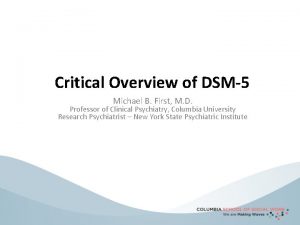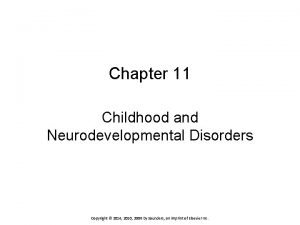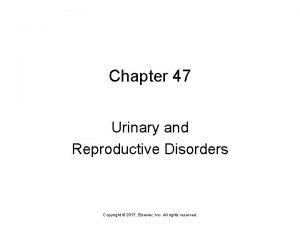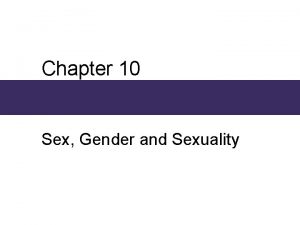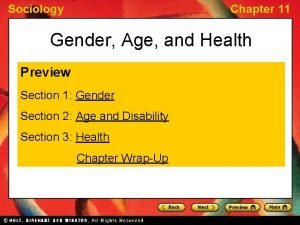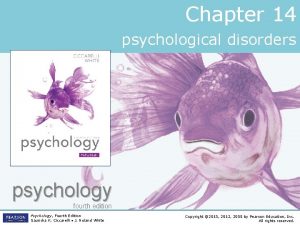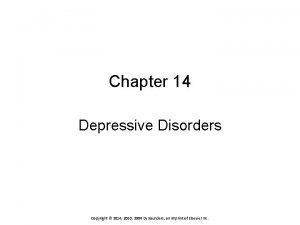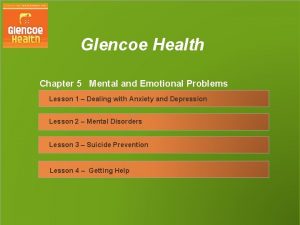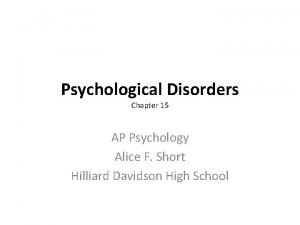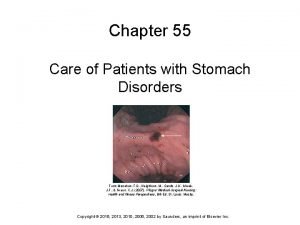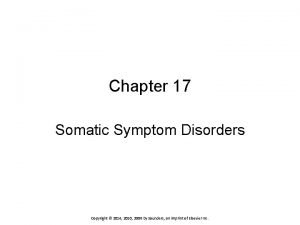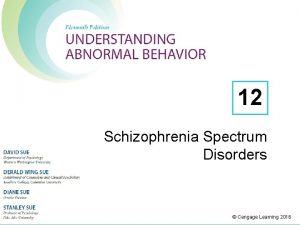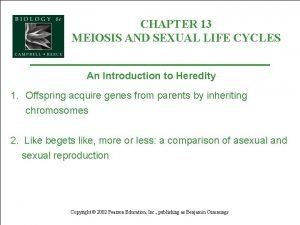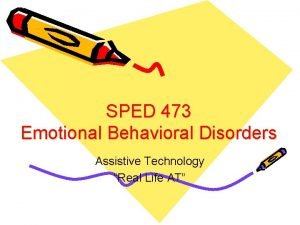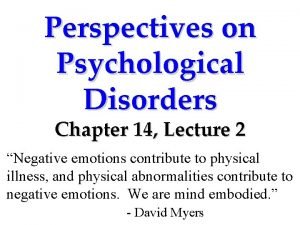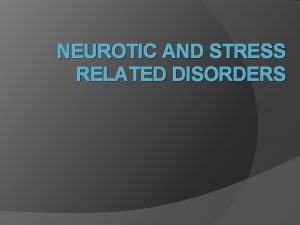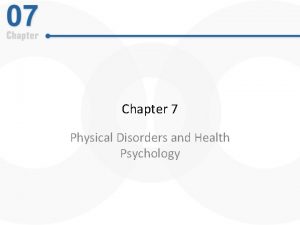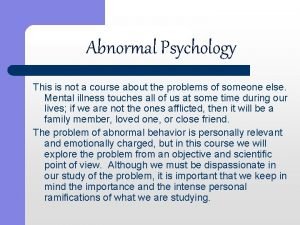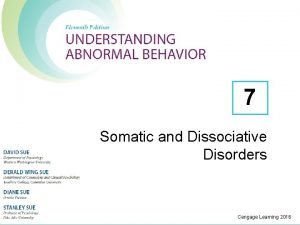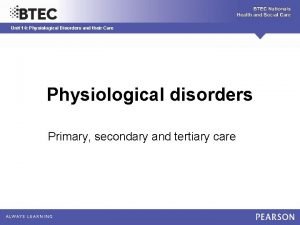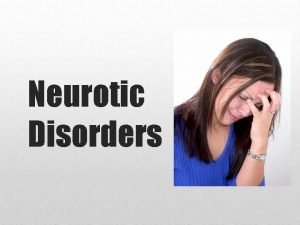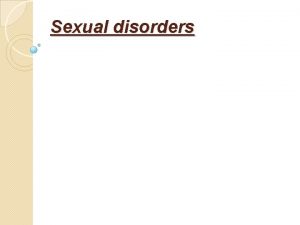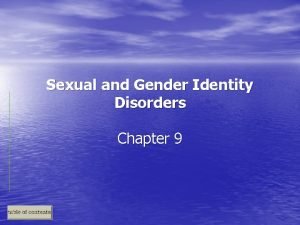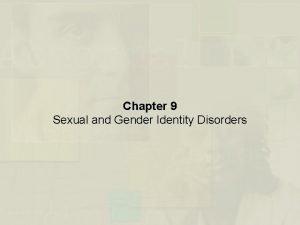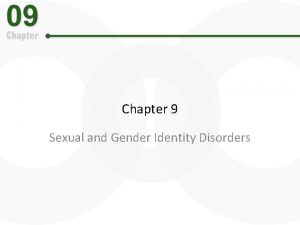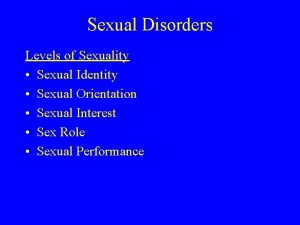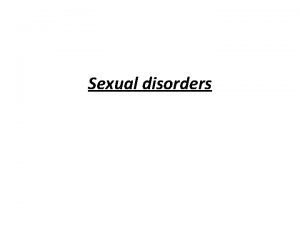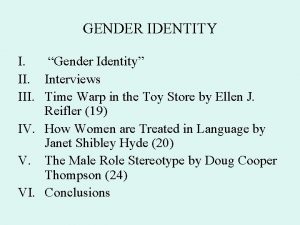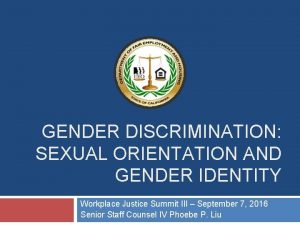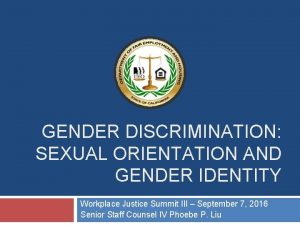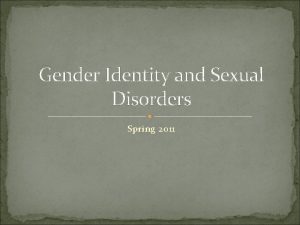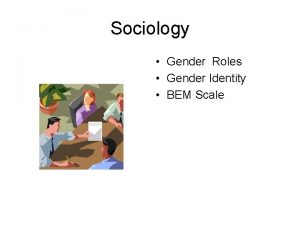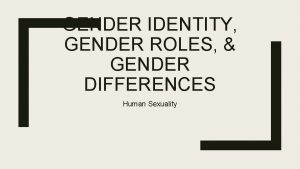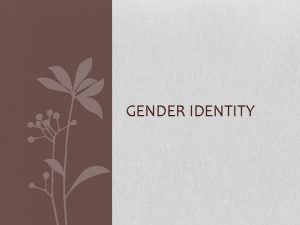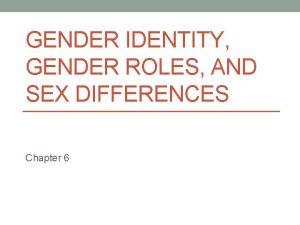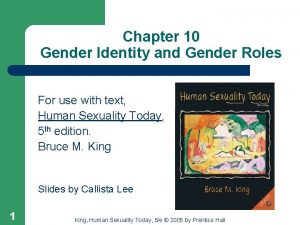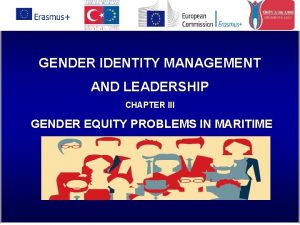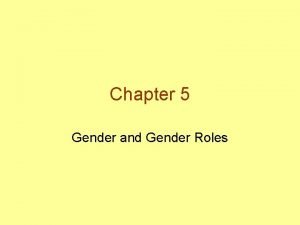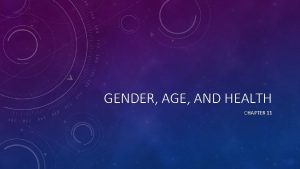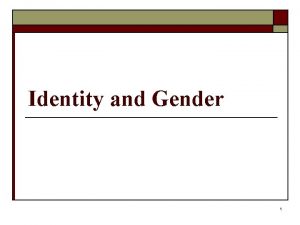Chapter 9 Sexual and Gender Identity Disorders Sexual















































![Paraphilias Sexual Masochism Disorder [9] The work group is recommending this disorder be renamed Paraphilias Sexual Masochism Disorder [9] The work group is recommending this disorder be renamed](https://slidetodoc.com/presentation_image/4979f0d03076e2301dd7ade33fc4bbe5/image-48.jpg)










- Slides: 58

Chapter 9 Sexual and Gender Identity Disorders

Sexual and Gender Identity Disorders: An Overview • What Is “Normal” vs. “Abnormal” Sexual Behavior? – Normative facts and statistics – Extent of gender differences in sexual behavior and attitudes – Cultural considerations • The Development of Sexual Orientation – Complex interaction of bio-psycho-social influences – The example of homosexuality • DSM-IV Sexual and Gender Identity Disorders – Gender identity disorder – Sexual dysfunctions – Paraphilias

Results of a survey of male sexual practices Figure 19. 1

Results of a survey of male sexual practices Figure 19. 1 a

Sequence of events leading to sexual orientation Figure 9. 2

Defining Gender Identity Disorder • Clinical Overview – Person feels trapped in the body of the wrong sex – Assume the identity of the desired sex, but the goal is not sexual • Causes are Unclear – Gender identity develops between 18 months and 3 years of age • Sex-Reassignment as a Treatment of Gender Identity Disorder – Who is a candidate? – Some basic prerequisites before surgery – 75% report satisfaction with new identity – Female-to-male conversions adjust better than male-to-female • Psychosocial Treatment of Gender Identity Disorder – Involve realigning the persons psychological gender with their biological sex – Few large scale studies

Overview of Sexual Dysfunctions • Sexual Dysfunctions Involve Desire, Arousal, and/or Orgasm • Males and Females Experience Parallel Versions of Most Dysfunctions – Affects about 43% of all females and 31% of males – Most prevalent class of disorder in the United States • Classification of Sexual Dysfunctions – Lifelong vs. acquired – Generalized vs. situational – Due to psychological factors alone or in combination with a medical condition

The human sexual response cycle Figure 9. 3

Sexual Desire Disorders: An Overview • Hypoactive Sexual Desire Disorder – Little or no interest in any type of sexual activity – Accounts for half of all complaints at sexuality clinics – 22% of women and 5% of men suffer from this disorder – Masturbation, sexual fantasies, and intercourse are rare in this disorder • Sexual Aversion Disorder – Little interest in sex – Extreme fear, panic, or disgust related to physical or sexual contact – 10% of males report panic attacks during attempted sexual activity

Sexual Arousal Disorders • Male Erectile Disorder – Difficulty achieving and maintaining an erection • Female Sexual Arousal Disorder – Difficulty achieving and maintaining adequate lubrication • Associated Features of Sexual Arousal Disorders – Problem is arousal, not desire – Problem affects about 5% of males, 14% of females – Males are more troubled by the problem than females – Erectile problems are the main reason males seek help

Estimated prevalence and severity of erectile dysfunction Figure 9. 4

Orgasm Disorders • Inhibited Orgasm: Female and Male Orgasmic Disorder – Inability to achieve orgasm despite adequate sexual desire and arousal – Rare condition in adult males, but is the most common complaint of adult females – 25% of adult females report significant difficulty reaching orgasm – 50% of adult females report experiencing regular orgasms during intercourse • Premature Ejaculation – Ejaculation occurring before the man or partner wishes it to – 21% of all adult males meeting criteria for premature ejaculation – Most prevalent sexual dysfunction in adult males – How soon is too soon? – Most common in younger, inexperienced males, but declines with age

Sexual Pain Disorders • Defining Feature: Marked Pain During Intercourse • Dyspareunia – Extreme pain during intercourse – Adequate sexual desire, and ability to attain arousal and orgasm – Must rule out medical reasons for pain – Affects 1% to 5% of men and about 10% to 15% of women • Vaginismus – Limited to females – Outer third of the vagina undergoes involuntary spasms – Complaints include feeling of ripping, burning, or tearing – Affects over 5% of women seeking treatment in the United States – Prevalence rates are higher in more conservative countries and subgroups

Assessing Sexual Behavior • Comprehensive Interview – Include a detailed history of sexual behavior, lifestyle, and associated factors • Medical Examination – Must rule out potential medical causes of sexual dysfunction • Psychophysiological Evaluation – Exposure to erotic material – Determine extent and pattern of physiological and subjective sexual arousal – Males – Penile strain gauge – Females – Vaginal photoplethysmograh

Causes and Treatment of Sexual Dysfunction • Biological Contributions – Physical disease and medical illness – Prescription medications – Use and abuse of alcohol and other drugs • Psychological Contributions – The role of “anxiety” vs. “distraction” – The nature and components of performance anxiety – Psychological profiles associated with sexual dysfunction • Social and Cultural Contributions – Erotophobia – Learned negative attitudes about sexuality – Negative or traumatic sexual experiences – Deterioration of interpersonal relationships, lack of communication

A model of functional and dysfunctional sexual arousal Figure 9. 5

Treatment of Sexual Dysfunction • Education Alone – Is surprisingly effective • Masters and Johnson’s Psychosocial Intervention – Education – Eliminate performance anxiety – Sensate focus and non-demand pleasuring • Additional Psychosocial Procedures – Squeeze technique – Premature ejaculation – Masturbatory training – Female orgasm disorder – Use of dilators – Vaginismus – Exposure to erotic material – Low sexual desire problems

Medical Treatment of Sexual Dysfunction • Erectile Dysfunction – Viagra – Is it really the wonder drug? – Injection of vasodilating drugs into the penis – Penile prosthesis or implants – Vascular surgery – Vacuum device therapy • Few Medical Procedures Exist for Female Sexual Dysfunction

Paraphilias: Clinical Descriptions and Causes • Nature of Paraphilias – Sexual attraction and arousal to inappropriate people, or objects – Often multiple paraphilic patterns of arousal – High comorbidity with anxiety, mood, and substance abuse disorders • Main Types of Paraphilias – Fetishism – Voyeurism – Exhibitionism – Transvestic fetishism – Sexual sadism and masochism – Pedophilia

Voyeurism and Exhibitionism • Voyeurism – Practice of observing an unsuspecting individual undressing or naked – Risk associated with “peeping” is necessary for sexual arousal • Exhibitionism – Exposure of genitals to unsuspecting strangers – Element of thrill and risk is necessary for sexual arousal

Fetishism and Transvestic Fetishism • Fetishism – Sexual attraction to nonliving objects (i. e. , inanimate and/or tactile) – Numerous targets of fetishistic arousal, fantasy, urges, and desires • Transvestic Fetishism – Sexual arousal with the act of cross-dressing – Males may show highly masculinized compensatory behaviors – Most do not show compensatory behaviors – Many are married and the behavior is known to spouse/partner

Sexual Sadism and Sexual Masochism • Sexual Sadism – Inflicting pain or humiliation to attain sexual gratification • Sexual Masochism – Suffer pain or humiliation to attain sexual gratification • Relation Between Sadism and Rape – Some rapists are sadists, but most do not show paraphilic patterns of arousal – Rapists show sexual arousal to violent sexual and non-sexual material

A model of the development of paraphilia Figure 9. 6

Pedophilia • Overview – Pedophiles – Sexual attraction to young children – Incest – Sexual attraction to one’s own children – Both may involve male and/or female children or very young adolescents – Pedophilia is rare, but not unheard of, in females • Associated Features – Most pedophiles and incest perpetrators are male – Incestuous males may be aroused to adult women; not true for pedophiles – Most rationalize the behavior and engage in other moral compensatory behavior

Pedophilia: Causes and Assessment • Causes of Pedophilia – Pedophilia is associated with sexual and social problems and deficits – Patterns of inappropriate arousal and fantasy may be learned early in life – The role of high sex drive, coupled with suppression of urges • Psychophysiological Assessment of Pedophilia – Assess extent of deviant patterns of sexual arousal – Assess extent of desired sexual arousal to adult content – Assess social skills and the ability to form relationships

Pedophilia: Psychosocial Treatment • Psychosocial Interventions – Most are behavioral and target deviant and inappropriate sexual associations – Covert sensitization – Imaginal procedure involving aversive consequences – Orgasmic reconditioning – Associate masturbation with appropriate stimuli – Family/marital therapy – Address interpersonal problems – Coping and relapse prevention – Teaches self-control and coping with risk • Efficacy of Psychosocial Interventions – About 70% to 100% of cases show improvement – Poorest outcomes are for rapists and persons with multiple paraphilias

Pedophilia: Drug Treatments • Medications: The Equivalent of Chemical Castration – Often used for dangerous sexual offenders • Types of Available Medications – Cyproterone acetate – Anti-androgen, reduces testosterone, sexual urges and fantasy – Medroxyprogesterone acetate – Depo-provera, also reduces testosterone – Triptoretin – A newer and more effective drug that inhibits gonadtropin secretion • Efficacy of Medication Treatments – Drugs work to greatly reduce sexual desire, fantasy, arousal – Relapse rates are high with medication discontinuation

Summary of Sexual and Gender Identity Disorders • Gender Identity and Gender Identity Disorder – Problem is not sexual; the problem is feeling trapped in body of wrong sex • Sexual Dysfunctions are Common in Men and Women – Problems with desire, arousal, and/or orgasm – Require comprehensive assessment and treatment approaches • Paraphilias Represent Inappropriate Sexual Attraction – Desire, arousal, and orgasm gone awry – Require comprehensive assessment and treatment approaches • Available Psychosocial and Medical Treatment Options are Generally Efficacious

Summary of Sexual and Gender Identity Disorders (cont. ) Figure 10. x 1 Exploring sexual and gender identity disorders

Summary of Sexual and Gender Identity Disorders (cont. ) Figure 10. x 2 Exploring sexual dysfunctions

Summary of Sexual and Gender Identity Disorders (cont. ) Figure 10. x 2 (cont. ) Exploring sexual dysfunctions

Summary of Sexual and Gender Identity Disorders (cont. ) Figure 10. x 1 (cont. ) Exploring sexual and gender identity disorders

Summary of Sexual and Gender Identity Disorders (cont. ) Figure 10. x 1 (cont. ) Exploring sexual and gender identity disorders

Web Sites • • • Kinsey Institute for Research in Sex, Gender, and Reproduction, Inc. – www. indiana. edu/~kinsey HISand. HER Health – www. hisandherhealth. com Sexual Health. Com – www. sexualhealth. com Health Central – http: //www. healthcentral. com/sexual-health/ Dr. Drew Pinsky – http: //www. lovelineshow. com/

DSM 5 - Proposed Changes

Hypersexual Disorder A. Over a period of at least six months, recurrent and intense sexual fantasies, sexual urges, and sexual behavior in association with four or more of the following five criteria: (1) Excessive time is consumed by sexual fantasies and urges, and by planning for and engaging in sexual behavior. [15] (2) Repetitively engaging in these sexual fantasies, urges, and behavior in response to dysphoric mood states (e. g. , anxiety, depression, boredom, irritability). [16] (3) Repetitively engaging in sexual fantasies, urges, and behavior in response to stressful life events. [17] (4) Repetitive but unsuccessful efforts to control or significantly reduce these sexual fantasies, urges, and behavior. [18] (5) Repetitively engaging in sexual behavior while disregarding the risk for physical or emotional harm to self or others. [19] B. There is clinically significant personal distress or impairment in social, occupational or other important areas of functioning associated with the frequency and intensity of these sexual fantasies, urges, and behavior. [20] C. These sexual fantasies, urges, and behavior are not due to direct physiological effects of exogenous substances (e. g. , drugs of abuse or medications) or to Manic Episodes. [21] D. The person is at least 18 years of age. Specify if: Masturbation, Strip Club, Pornography, Sexual Behavior with Consenting Adults, Cyber Sex, Phone Sex Specify if: In remission (State duration of remission in months___) , in a controlled environment

Paraphilic Coercive Disorder A. Over a period of at least six months, recurrent, and intense sexual arousal from sexual coercion, as manifested by fantasies, urges, or behaviors. [23] B. The person has clinically significant distress or impairment in important areas of functioning, or has sought sexual stimulation from forcing sex on three or more nonconsenting persons on separate occasions. [24] C. The diagnosis of Paraphilic Coercive Disorder is not made if the patient meets criteria for a diagnosis of Sexual Sadism Disorder. [25] Specify if: In Remission (State duration of remission in months: ____), In a Controlled Environment

Sexual Interest/Arousal Disorder in Women • Includes Hypoactive Sexual Desire Disorder and Female Sexual Arousal Disorder A. Lack of sexual interest/arousal of at least 6 months duration as manifested by at least 4 of the following indicators (1) Absent/reduced interest in sexual activity (2) Absent/reduced sexual/erotic thoughts or fantasies (3) No initiation of sexual activity and is rarely or never receptive to a partner’s attempts to initiate (4) Absent/reduced sexual excitement/pleasure during sexual activity (on all or almost all sexual encounters) (5) Desire is rarely or never triggered by any internal or external sexual/erotic stimulus (e. g. , written, verbal, visual, etc. ) (6) Absent/reduced genital and/or nongenital sensations during sexual activity (on all or almost all sexual encounters) B. The problem causes clinically significant distress or impairment. C. The sexual dysfunction is not better accounted for by another Axis I disorder (except another sexual dysfunction) and is not due exclusively to the direct physiological effects of a substance (e. g. , a drug of abuse, a medication) or a general medical condition Specify If: 1) Lifelong (since the onset of sexual activity) vs. Acquired, 2) Generalized vs. Situational, 3) Partner factors (partner’s sexual problems, partner’s health status), 4) Relationship factors (e. g. , poor communication, relationship discord, discrepancies in desire for sexual activity), 5) Individual vulnerability factors (e. g. , depression or anxiety, poor body image, history of abuse experience), 6) Cultural/religious factors (e. g. , inhibitions related to prohibitions against sexual activity), 7) With medical factors relevant to prognosis, course, or treatment

Genito-Pelvic Pain/Penetration Disorder • Includes Vaginismus (Not due to a medical condition) and Dyspareunia (Not due to a medical condition) A. Persistent or recurrent difficulties for 6 months or more with at least one of the following: 1. Inability to have vaginal intercourse/penetration 2. Marked vulvovaginal or pelvic pain during vaginal intercouse/penetration attempts 3. Marked fear or anxiety either about vulvovaginal or pelvic pain or vaginal penetration 4. Marked tensing or tightening of the pelvic floor muscles during attempted vaginal penetration B. The problem causes clinically significant distress or impairment. C. The sexual dysfunction is not better accounted for by another Axis I disorder (except another sexual dysfunction) and is not due to the effects of a substance (e. g. , a drug of abuse, a medication) or a general medical condition Addition of the following specifiers: 1) Lifelong (since the onset of sexual activity) vs. Acquired 2) Generalized vs. Situational 3) Partner factors (parter's sexual problems, partner's health status) 4) Relationship factors (e. g. , poor communication, relationship discord, discrepancies in desire for sexual activity) 5) Individual vulnerability factors or psychiatric comorbidity (e. g. , depression or anxiety, poor body image, history of abuse experience) 6) Cultural/religious factors (e. g. , inhibitions related to prohibitions against sexual activity) 7) With medical factors relevant to prognosis, course, or treatment

Sexual Dysfunction Due to a General Medical Condition Includes previous diagnoses of Other Female Sexual Dysfunction Due to a General Medical Condition, Other Male Sexual Dysfunction Due to a General Medical Condition, Female Hypoactive Sexual Desire Disorder Due to a General Medical Condition, Male Erectile Disorder Due to a General Medical Condition, Female Dyspareunia Due to a General Medical Condition, and Male Dyspareunia Due to a General Medical Condition A. Clinically significant sexual dysfunction that results in marked distress or interpersonal difficulty predominates in the clinical picture B. There is evidence from the history, physical examination, or laboratory findings that the sexual dysfunction is due to a general medical condition C. The disturbance is not better accounted for by another mental disorder (e. g. , Major Depressive Disorder) Specifiers: With impaired interest/arousal, With impaired erectile function, With impaired orgasm, With early ejaculation, With genito-pelvic pain and/or penetration difficulties

Removals / Unchanged • • Sexual Aversion Disorder - To be removed from the DSM Sexual Disorder NOS & Substance-Induced Sexual Dysfunction – No change

Gender Identity Disorder Gender Incongruence (in children) A. A marked incongruence between one’s experienced/expressed gender and assigned gender, of at least 6 months duration, as manifested by at least 6 of the following indicators (including A 1): 1. a strong desire to be of the other gender or an insistence that he or she is the other gender (or some alternative gender different from one's assigned gender) 2. in boys, a strong preference for cross-dressing or simulating female attire; in girls, a strong preference for wearing only typical masculine clothing and a strong resistance to the wearing of typical feminine clothing 3. a strong preference for cross-gender roles in make-believe or fantasy play 4. a strong preference for the toys, games, or activities typical of the other gender 5. a strong preference for playmates of the other gender 6. in boys, a strong rejection of typically masculine toys, games, and activities and a strong avoidance of rough-and-tumble play; in girls, a strong rejection of typically feminine toys, games, and activities [ 7. a strong dislike of one’s sexual anatomy 8. a strong desire for the primary and/or secondary sex characteristics that match one’s experienced gender Subtypes: With a disorder of sex development, Without a disorder of sex development

Gender Identity Disorder Gender Incongruence (in Adolescents or Adults) A. A marked incongruence between one’s experienced/expressed gender and assigned gender, of at least 6 months duration, as manifested by 2 or more of the following indicators: 1. a marked incongruence between one’s experienced/expressed gender and primary and/or secondary sex characteristics (or, in young adolescents, the anticipated secondary sex characteristics) 2. a strong desire to be rid of one’s primary and/or secondary sex characteristics because of a marked incongruence with one’s experienced/expressed gender (or, in young adolescents, a desire to prevent the development of the anticipated secondary sex characteristics) 3. a strong desire for the primary and/or secondary sex characteristics of the other gender 4. a strong desire to be of the other gender (or some alternative gender different from one’s assigned gender) 5. a strong desire to be treated as the other gender (or some alternative gender different from one’s assigned gender) 6. a strong conviction that one has the typical feelings and reactions of the other gender (or some alternative gender different from one’s assigned gender) Subtypes: With a disorder of sex development, Without a disorder of sex development

Paraphilias Exhibitionistic Disorder The work group is recommending this disorder be renamed from Exhibitionism to Exhibitionistic Disorder. A. Over a period of at least six months, recurrent and intense sexual arousal from the exposure of one’s genitals to an unsuspecting stranger, as manifested by fantasies, urges, or behaviors. B. The person has clinically significant distress or impairment in important areas of functioning, or has sought sexual stimulation from exposing the genitals to three or more unsuspecting strangers on separate occasions. Specify type: • Sexually Attracted to Exposing Genitals to Pubescent or Prepubescent Individuals (Generally Younger Than Age 15) • Sexually Attracted to Exposing Genitals to Physically Mature Individuals (Generally Age 15 or Older) • Equally Sexually Attracted to Exposing Genitals to Both Age Groups Specify if: • In Remission (No Distress, Impairment, or Recurring Behavior and in an Uncontrolled Environment): State duration of remission in months: ____ • In a Controlled Environment

Paraphilias Fetishistic Disorder The work group is recommending this disorder be renamed from Fetishism to Fetishistic Disorder. A. Over a period of at least six months, recurrent and intense sexual arousal from eaither the use of non-living objects or a highly specific focus on non-genital body part(s), as manifested by fantasies, urges, or behaviors. B. The person has clinically significant distress or impairment from important areas of functioning. C. The fetish objects are not limited to articles of clothing used in cross-dressing (as in Transvestic Disorder) or devices specifically designed for the purpose of tactile genital stimulation (e. g. vibrator). Specify: • Body part(s): • Non-living object(s): • Other: Specify if: • In Remission (No Distress, Impairment, or Recurring Behavior and in an Uncontrolled Environment): State duration of remission in months: ____ • In a Controlled Environment

Paraphilias Frotteuristic Disorder The work group is recommending this disorder be renamed from Frotteurism to Frotteuristic Disorder. A. Over a period of at least six months, recurrent and intense sexual arousal from touching or rubbing against a nonconsenting person, as manifested by fantasies, urges, or behaviors. B. The person has clinically significant distress or impairment in important areas of functioning, or has sought sexual stimulation from touching and rubbing against three or more nonconsenting persons on separate occasions. [2] Specify if: • In Remission (No Distress, Impairment, or Recurring Behavior and in an Uncontrolled Environment): State duration of remission in months: ____ • In a Controlled Environment

Paraphilias Pedohebephilic Disorder The work group is recommending this disorder be renamed from Pedophilia to Pedohebephilic Disorder. A. Over a period of at least six months, one or both of the following, as manifested by fantasies, urges, or behaviors: • (1) recurrent and intense sexual arousal from prepubescent or pubescent children [5] • (2) equal or greater arousal from such children than from physically mature individuals [6] • B. One or more of the following signs or symptoms: • (1) the person has clinically significant distress or impairment in important areas of functioning from sexual attraction to children • (2) the person has sought sexual stimulation, on separate occasions, from either of the following: • (a) two or more different children, if both are prepubescent • (b) three or more different children, if one or more are pubescent [7] • (3) repeated use of , and greater arousal from, pornography depicting prepubescent or pubescent children than from pornography depicting physically mature persons, for a period of six months or longer [8] C. The person is at least age 18 years and at least five years older than the children in Criterion A or Criterion B. Specify type: • Pedophilic Type—Sexually Attracted to Prepubescent Children (Generally Younger than 11) • Hebephilic Type—Sexually Attracted to Pubescent Children (Generally Age 11 through 14) • Pedohebephilic Type—Sexually Attracted to Both Specify type: • Sexually Attracted to Males • Sexually Attracted to Females • Sexually Attracted to Both Specify if: • In Remission (No Distress, Impairment, or Recurring Behavior and in an Uncontrolled Environment): State duration of remission in months: ____ • In a Controlled Environment
![Paraphilias Sexual Masochism Disorder 9 The work group is recommending this disorder be renamed Paraphilias Sexual Masochism Disorder [9] The work group is recommending this disorder be renamed](https://slidetodoc.com/presentation_image/4979f0d03076e2301dd7ade33fc4bbe5/image-48.jpg)
Paraphilias Sexual Masochism Disorder [9] The work group is recommending this disorder be renamed from Sexual Masochism to Sexual Masochism Disorder. A. Over a period of at least six months, recurrent and intense sexual arousal from the act of being humiliated, beaten, bound, or otherwise made to suffer, as manifested by fantasies, urges, or behaviors. B. The person has clinically significant distress or impairment in important areas of functioning. Specify if: • With Asphyxiophilia (Sexually Aroused by Asphyxiation) Specify if: • In Remission (No Distress, Impairment, or Recurring Behavior and in an Uncontrolled Environment): State duration of remission in months: ____ • In a Controlled Environment

Paraphilias Sexual Sadism Disorder The work group is recommending this disorder be renamed from Sexual Sadism to Sexual Sadism Disorder. A. Over a period of at least six months, recurrent and intense sexual arousal from the physical or psychological suffering of another person, as manifested by fantasies, urges, or behaviors. B. The person has clinically significant distress or impairment in important areas of fucntioning, or has sought sexual stimulation from behaviors involving the physical or psychological suffering of two or more nonconsenting persons on separate occasions. Specify if: • In Remission (No Distress, Impairment, or Recurring Behavior and in an Uncontrolled Environment): State duration of remission in months: ____ • In a Controlled Environment

Paraphilias Transvestic Disorder The work group is recommending this disorder be renamed from Transvestic Fetishism to Transvestic Disorder. A. Over a period of at least six months, recurrent and intense sexual arousal from cross‑dressing, as manifested by fantasies, urges, or behaviors. B. The person has clinically significant distress or impairment in important areas of functioning. Specify if: • With Fetishism (Sexually Aroused by Fabrics, Materials, or Garments) • With Autogynephilia (Sexually Aroused by Thought or Image of Self as Female) • With Autoandrophilia (Sexually Aroused by Thought or Image of Self as Male) • • Specify if: • In Remission (No Distress, Impairment, or Recurring Behavior and in an Uncontrolled Environment): State duration of remission in months: ____ • In a Controlled Environment

Paraphilias Voyeuristic Disorder The work group is recommending this disorder be renamed from Voyeurism to Voyeuristic Disorder. A. Over a period of at least six months, recurrent and intense sexual arousal from observing an unsuspecting person who is naked, in the process of disrobing, or engaging in sexual activity, as manifested by fantasies, urges, or behaviors. B. The person has clinically significant distress or impairment in important areas of functioning, or has sought sexual stimulation from observing three or more unsuspecting persons who are naked, disrobing, or engaging in sexual activity on separate occasions. [2] Specify if: • In Remission (No Distress, Impairment, or Recurring Behavior and in an Uncontrolled Environment): State duration of remission in months: ____ • In a Controlled Environment

Paraphilias Paraphilic Disorders Not Otherwise Specified This category is included for coding Paraphilic Disorders that do not meet the criteria for any of the specific paraphilic categories. Examples include, but are not limited to, telephone scatologia (obscene phone calls), necrophilia (corpses), zoophilia (animals), coprophilia (feces), klismaphilia (enemas) and urophilia (urine). The person has clinically significant distress or impairment in important areas of functioning. Specify if: • In Remission (No Distress, Impairment, or Recurring Behavior and in an Uncontrolled Environment): State duration of remission in months: ____ • In a Controlled Environment

Sexual Dysfunctions Hypoactive Sexual Desire Disorder In Men A. Persistently or recurrently deficient (or absent) sexual fantasies and desire for sexual activity. The judgment of deficiency or absence is made by the clinician, taking into account factors that affect sexual functioning, such as age and the context of the person's life. B. The disturbance causes marked distress or interpersonal difficulty. C. The sexual dysfunction is not better accounted for by another Axis I disorder (except another Sexual Dysfunction) and is not due exclusively to the direct physiological effects of a substance (e. g. , a drug of abuse, a medication) or a general medical condition.

Sexual Dysfunctions Erectile Disorder The work group is recommending this disorder be renamed from Male Erectile Disorder to Erectile Disorder. A. Failure to obtain or maintain an erection until completion of the sexual activity or a marked decrease in erectile turgidity on all or almost all of seuxal activity for at least 6 months duration 23 B. The problem causes clinically significant distress or impairment 24 C. The sexual dysfunction is not better accounted for by another Axis I disorder (except another Sexual Dysfunction) and is not due exclusively to the direct physiological effects of a substance (e. g. , a drug of abuse, a medication) or a general medical condition Addition of the following specifiers: • 1) Lifelong (since the onset of sexual activity) vs. Acquired • 2) Generalized vs. Situational • 3) Partner factors (partner's sexual problems, partner's health status) • 4) Relationship factors (e. g. , poor communication, relationship discord, discrepancies in desire for sexual activity) • 5) Individual vulnerability factors or psychiatric comorbidity (e. g. , depression or anxiety, poor body image, history of abuse experience) • 6) Cultural/religious factors (e. g. , inhibitions related to prohibitions against sexual activity) • 7) With medical factors relevant to prognosis, course, or treatment

Sexual Dysfunctions Female Orgasmic Disorder A. At least one of the two following symptoms where the symptom(s) must have been present for at least 6 months and be experienced on all or almost all occasions of sexual activity: • 1. Marked delay in, marked infrequency, or absence of, orgasm • 2. Markedly reduced intensity of orgasmic sensation B. The problem causes clinically significant distress or impairment C. The sexual dysfunction is not better accounted for by another Axis I disorder (except another Sexual Dysfunction) and is not due to the effects of a substance (e. g. , a drug of abuse, a medication) or a general medical condition Addition of the following specifiers: • 1) Lifelong (since the onset of sexual activity) vs. Acquired • 2) Generalized vs. Situational • 3) With concomitant problems in sexual interest/sexual arousal • 4) Partner factors (partner’s sexual problems, partner’s health status) • 5) Relationship factors (e. g. , poor communication, relationship discord, discrepancies in desire for sexual activity) • (6) Individual vulnerability factors or psychiatric comorbidity (e. g. , depression or anxiety, poor body image, history of abuse experience) • (7) Cultural/religious factors (e. g. , inhibitions related to prohibitions against sexual activity) • (8) With medical factors relevant to prognosis, course or treatment

Sexual Dysfunctions Delayed Ejaculation The work group is recommending this disorder be renamed from Male Orgasmic Disorder to Delayed Ejaculation. A. Delayed or absent ejaculation occurring on all or almost all sexual encounters for at least 6 months duration. B. The problem causes clinically significant distress or impairment. C. The sexual dysfunction is not better accounted for by another Axis I disorder (except another Sexual Dysfunction) and is not due to the effects of a substance (e. g. , a drug of abuse, a medication) or a general medical condition Addition of the following specifiers: • 1) Lifelong (since the onset of sexual activity) vs. Acquired • 2) Generalized vs. Situational • 3) Partner factors (partner's sexual problems, partner's health status) • 4) Relationship factors (e. g. , poor communication, relationship discord, discrepancies in desire for sexual activity) • 5) Individual vulnerability factors or psychiatric comorbidity (e. g. , depression or anxiety, poor body image, history of abuse experience) • 6) Cultural/religious factors (e. g. , inhibitions related to prohibitions against sexual activity) • 7) With medical factors relevant to prognosis, course, or treatment

Sexual Dysfunctions Early Ejaculation The work group is recommending that this disorder be renamed from Premature Ejaculation to Early Ejaculation. A. Repetitive pattern of ejaculation occurring within approximately one minute of beginning of sexual activity on all or almost all sexual occasions and before the person wishes it. The difficulty must persist for a minimum of 6 months. B. The problem causes clinically significant distress or impairment. 27 C. The sexual dysfunction is not better accounted for by another Axis I disorder (except another sexual dysfunction) and is not due to the effects of a substance (e. g. , a drug of abuse, a medication) or a general medical condition. Addition of the following specifiers: • 1) Lifelong (since the onset of sexual activity) vs. Acquired • 2) Generalized vs. Situational • 3) Partner factors (partner's sexual problems, partner's health status) • 4) Relationship factors (e. g. , poor communication, relationship discord, discrepancies in desire for sexual activity) • 5) Individual vulnerability factors or psychiatric comorbidity (e. g. , depression or anxiety, poor body image, history of abuse experience) • 6) Cultural/religious factors (e. g. , inhibitions related to prohibitions against sexual activity) • 7) With medical factors relevant to prognosis, course, or treatment

Sexual Dysfunctions Sexual Dysfunction NEC (Not Elsewhere Classified) Sexual Aversion Disorder • Fear and avoidance of all or almost all sexual contact that causes clinically significant distress or impairment
 Sexual orientation gender identity
Sexual orientation gender identity Strategic gender needs and practical gender needs
Strategic gender needs and practical gender needs Gender and sexual orientation ap psychology
Gender and sexual orientation ap psychology Gender roles and identity
Gender roles and identity Sample dsm-5 diagnosis format
Sample dsm-5 diagnosis format Gender identity
Gender identity Gender identity tagalog
Gender identity tagalog Identity map
Identity map Chapter 8 skin disorders and diseases review questions
Chapter 8 skin disorders and diseases review questions Chapter 6 musculoskeletal system diseases and disorders
Chapter 6 musculoskeletal system diseases and disorders Chapter 46 digestive and endocrine disorders
Chapter 46 digestive and endocrine disorders Types of somatic disorder
Types of somatic disorder Chapter 29 endocrine and metabolic disorders
Chapter 29 endocrine and metabolic disorders Chapter 21 mental health diseases and disorders
Chapter 21 mental health diseases and disorders Chapter 18 eating and feeding disorders
Chapter 18 eating and feeding disorders Chapter 17 reproductive system diseases and disorders
Chapter 17 reproductive system diseases and disorders Chapter 15 nervous system diseases and disorders
Chapter 15 nervous system diseases and disorders Chapter 15 anxiety and obsessive-compulsive disorders
Chapter 15 anxiety and obsessive-compulsive disorders Chapter 11 childhood and neurodevelopmental disorders
Chapter 11 childhood and neurodevelopmental disorders Seborrheic keratoses
Seborrheic keratoses Milady chapter 10 review questions
Milady chapter 10 review questions Plicatured nail
Plicatured nail Chapter 8 cardiovascular system
Chapter 8 cardiovascular system Milady chapter 8 skin disorders and diseases
Milady chapter 8 skin disorders and diseases Chapter 47 urinary and reproductive disorders
Chapter 47 urinary and reproductive disorders An eating disorder in which people overeat compulsively
An eating disorder in which people overeat compulsively Chapter 10 lymphatic system diseases and disorders
Chapter 10 lymphatic system diseases and disorders Chapter 10 sex gender and sexuality
Chapter 10 sex gender and sexuality Chapter 11 gender age and health review worksheet answers
Chapter 11 gender age and health review worksheet answers Chapter 18 psychological disorders review worksheet
Chapter 18 psychological disorders review worksheet Chapter 11 genetic disorders concept mapping
Chapter 11 genetic disorders concept mapping Chapter 18 psychological disorders
Chapter 18 psychological disorders Chapter 14 psychological disorders
Chapter 14 psychological disorders Chapter 14 depressive disorders
Chapter 14 depressive disorders Glencoe health chapter 5 assessment answers
Glencoe health chapter 5 assessment answers Chapter 5 lesson 2 mental disorders
Chapter 5 lesson 2 mental disorders Chapter 14 psychological disorders
Chapter 14 psychological disorders Ap psychology chapter 15 psychological disorders
Ap psychology chapter 15 psychological disorders Chapter 55 care of patients with stomach disorders
Chapter 55 care of patients with stomach disorders Chapter 17 somatic symptom disorders
Chapter 17 somatic symptom disorders Chapter 12 schizophrenia spectrum disorders
Chapter 12 schizophrenia spectrum disorders Chapter 12 schizophrenia spectrum disorders
Chapter 12 schizophrenia spectrum disorders Pedigree miscarriage symbol
Pedigree miscarriage symbol Chapter 10 sexual reproduction and genetics
Chapter 10 sexual reproduction and genetics Metaphase ii
Metaphase ii Chapter 13 meiosis and sexual life cycles
Chapter 13 meiosis and sexual life cycles Unit 14 health and social care diabetes
Unit 14 health and social care diabetes Bipolar and other related disorders
Bipolar and other related disorders Bipolar and other related disorders
Bipolar and other related disorders Assistive technology for emotional and behavioral disorders
Assistive technology for emotional and behavioral disorders Puberty and autism spectrum disorders
Puberty and autism spectrum disorders Axis 1 and axis 2 disorders
Axis 1 and axis 2 disorders Neurosis disorder
Neurosis disorder Physical disorders and health psychology
Physical disorders and health psychology Personality disorder vs mental illness
Personality disorder vs mental illness Axis 1 and 2 disorders
Axis 1 and 2 disorders Somatic symptom and related disorders
Somatic symptom and related disorders Physiological disorders and their care
Physiological disorders and their care Neurosis disorder
Neurosis disorder




